Written by Veronica |
As one of the four ancient civilizations, China has a profound history of over 5,000 years, which leaves the country countless historical sites, from the iconic Great Wall to the majestic Forbidden City, from the sacred Potala Palace to the artistic wonders of Magao Grottoes…
In this article, we will walk through the time tunnel of history to explore 8 most famous historical sites in China and trace the glorious past of the country.
Great Wall of China
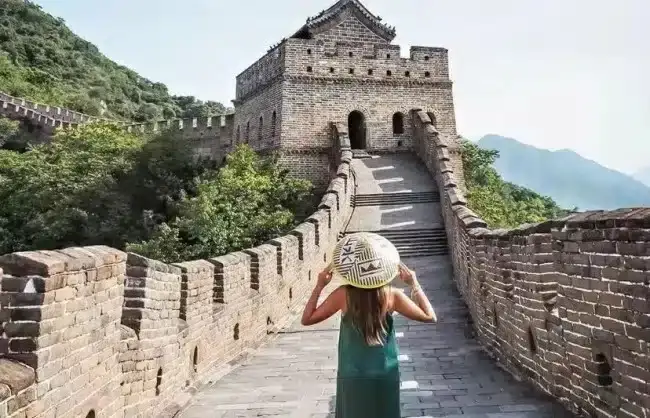
History: More than 2,700 years
Total Length: 21196.18 kilometers across 15 provinces and regions
Most Famous Sections: Badaling, Mutianyu, Jinshanling, Simatai, Shanhaiguan, Jiayuguan…
Recommended Visiting Length: Half – 1 day
The Great Wall is considered one of the historical landmarks of China. It was a huge ancient defensive project built along the northern border of the central plain against invasions of nomadic tribes. The construction work of Great Wall lasted for more than 2,000 years from the Spring and Autumn Period (770-476BC) until Ming Dynasty (1368-1644).
Today, existing sections of Great Wall snakes about 21,000 kilometers westward from Hushan in Liaoning to Jiayuguan in Gansu. Containing some of the best-preserved sections in China, Beijing is always the no.1 destination for visitors to take in the grandeur of the Great Wall, especially for first-timers. There are not only sections like Badaling and Mutianyu with gentle slope and perfect facilities to ensure a relaxing hiking tour, but also steep, less-renovated Jinshanling and Simatai for tourists to take a challenge and see the pristine looking of Great Wall.
✔ Recommended Tours: Beijing Great Wall Hiking Tours
Forbidden City, Beijing
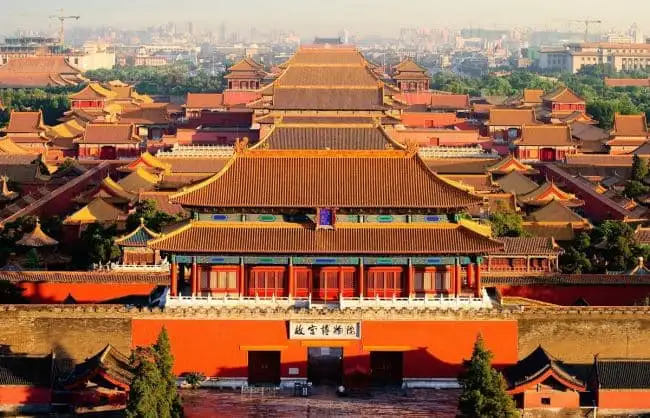
History: Over 600 years
Total Area: 720,000 square meters (construction area: 150,000 square meters)
Highlights: Grand imperial architectures, exquisite garden, a large collection of imperial treasure
Recommended Visiting Length: Half – 1 day
Location: No. 4, Jingshan Qian Street, Dongcheng District, Beijing City (in the very heart of Beijing)
Nestled along the central axis of China’s capital, the Forbidden City, serving as home to 24 emperors of the Ming and Qing dynasties (1368-1911), is one of the most famous historical sites in Beijing, offering an immersive trip to trace the imperial past of China.
The Forbidden City is the largest and most complete existing architectural complex of ancient royal palace in the world, consisting of more than 70 palaces and about 9,000 rooms. It is divided into 2 parts for different purposes. The Outer Court are mainly magnificent halls for emperors to handle routine affairs and hold grand ceremonies while the Inner Court served as the living quarter for royal members.
Also known as the Palace Museum, the Forbidden City displays more than 1,800,000 pieces of imperial treasures. All of these were crafted from gold, silver, jade, pearls and other precious materials, representing the highest level of handicraft during that time.
✔ Recommended Tour: 2 Days Beijing Stopover Tour: Great Wall+Forbidden City
Terracotta Army, Xi’an
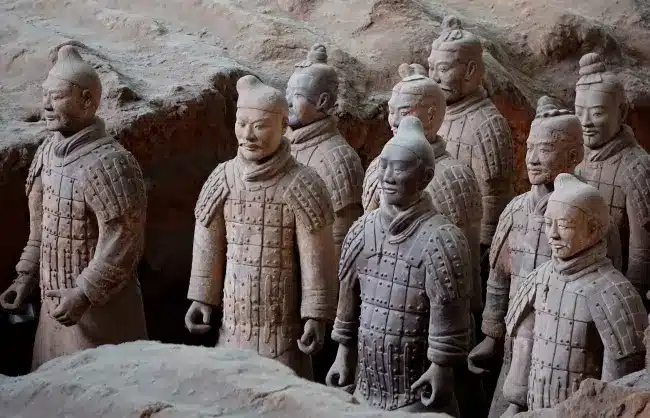
History: over 2,200 years
Area: Pit 1: 14,260 square meters; Pit 2: 6,000 square meters; Pit 3: 520 square meters
Highlights: More than 8,000 life-sized pottery figures and horses, vivid bronze chariots
Recommended Visiting Length: 2-3 hours
Location: Qinling North Road, Lintong District, Xi’an City, Shaanxi Province (40km to downtown area)
Discovered by chance in 1974, the Terracotta Army is one of the world’s most remarkable archaeological findings in the 20th century and is also reputed as the “eighth wonder of the world”. This grand project was said to have been constructed to guard the mausoleum of Emperor Qin Shi Huang (259-210BC), the first emperor in the history of China.
A visit to the Terracotta Army Museum, one of the historical sites in China, offers a captivating glimpse into the military might during the rule of Qin Shi Huang. Here, you will witness over 8,000 life-sized terracotta soldiers that are still standing in formation. Each figure is distinct, with different expressions, hairstyles and armors. Besides, a lot of bronze artifacts and delicate weapons have also been excavated, showcasing the supreme craftmanship 2,200 years ago.
✔ Recommended Tours: Terracotta Army Tours
Summer Palace, Beijing
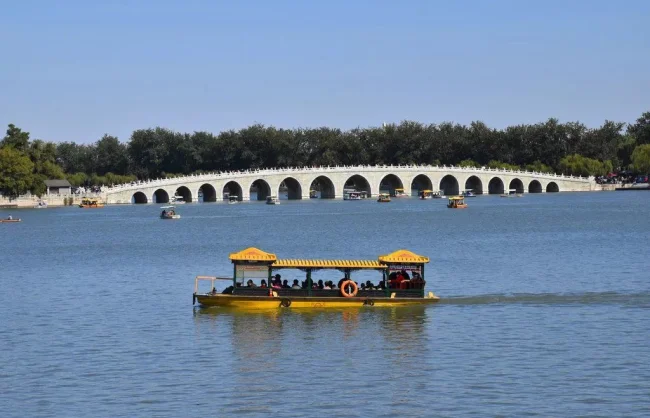
History: Around 270 years
Total Area: 3,000,000 square meters (water surface occupies three quarters of it)
Highlights: Longevity Hill, Kunming Lake, Seventeen-Arch Bridge, Long Corridor, intricate gardens, Buddhist buildings…
Recommended Visiting Length: Half a day
Location: No. 19, Xinjian Gongmen Road, Haidian District, Beijing City (15km to downtown Beijing)
As a tranquil retreat for royal family during the Qing Dynasty (1644-1911), Summer Palace, seated in the western suburbs of Beijing, is a perfect destination to escape the hustle and bustle of the modern city, and another famous historical site in China. It replicated the poetic scenery of West Lake in Hangzhou as well as exquisite design of classical gardens in Suzhou, showcasing a perfect blend of man-made architectures and scenery of Longevity Hill and Kunming Lake.
Walk up the Longevity Hill, and you will admire solemn Buddhist complexes and enjoy sweeping views of the entire garden. You can also enjoy a relaxing time taking a boat ride on the shimmering Kunming Lake, or simply sitting by the water to bask in the same serenity that once embraced by royal members.
✔ Recommended Tour: 4 Days Beijing Essence Tour
Potala Palace, Lhasa, Tibet
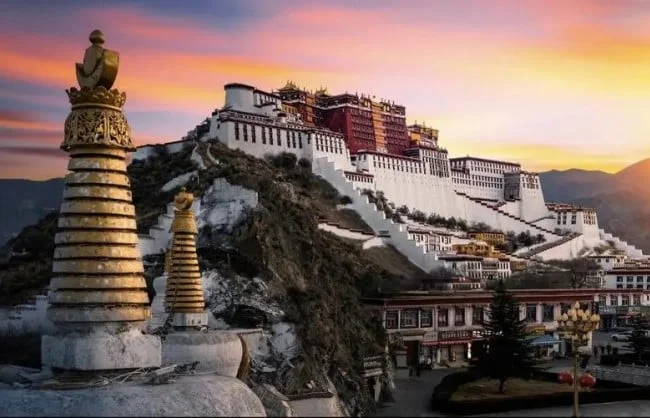
History: Over 1,300 years
Altitude: 3,700 meters
Total Area: 400,000 square meters
Highlights: Red Palace, White Palace, a variety of artifacts of Tibetan Buddhism
Recommended Visiting Length: 3-4 hours
Location: On Red Hill in the northwest of Lhasa City, Tibet
Potala Palace, a sacred religious site perched atop the Red Hill in Lhasa, is the most famous historical site in Tibet, China. It was originally the regal palace built by Songtsen Gampo, the king of Tibet, more than 1,300 years ago. After a grand renovation in the 17th century, it finally served as the place for religious and political activities, and also the residence for successive Dalai Lamas.
Potala Palace mainly consists of Red Palace and White Palace. Its striking white and red exterior, adorned with intricate artwork, makes it an unmistakable landmark against the backdrop of the Himalayas. Step inside, and you’ll be greeted by an awe-inspiring display of religious relics, including gilded stupas, stunning murals, Thangkas, Buddha statues, gold and silver wares, as well as over 60,000 ancient scriptures.
✔ Recommended Tour: 8 Days Classic Tibet Tour from Lhasa to Everest Base
Xi’an City Wall, Shaanxi Province
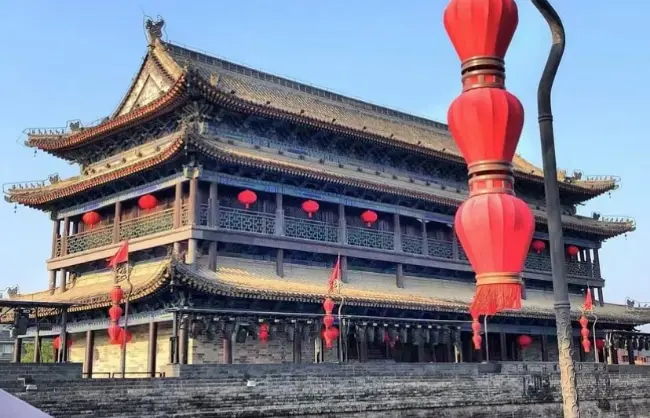
History: More than 600 years
Circumference: 13.74 kilometers
Highlights: China’s best-preserved city wall, panoramic views of Xi’an, cultural performances and events…
Recommended Visiting Length: 3-4 hours
Location: Surrounding the central area of Xi’an City, Shaanxi Province
Step back in time with a visit to the ancient Xi’an City Wall, which is one of the most famous historical sites in China. It is the largest and the most complete city wall of the country, guarding the central area of Xi’an City since Ming Dynasty. Go along the wall, and you will encounter different kinds of ancient military facilities, such as moat, watchtowers, crenels and parapets.
Today, the Ancient City Wall provides a nice promenade where locals and tourists can enjoy a leisurely stroll or bike ride. From the top of the wall, you can enjoy the panoramic views of the city’s modern skyline and ancient neighborhoods as well.
When the night comes, there will be a wonderful performance at the South Gate, presenting the grand welcoming ceremony of the prosperous Tang Dynasty (618-907). It will be a great chance to experience the splendid culture of that period and also immerse in the historical ambience of Xi’an.
✔ Recommended Tour: Xi’an Highlight Day Tour
Mogao Grottoes, Dunhuang
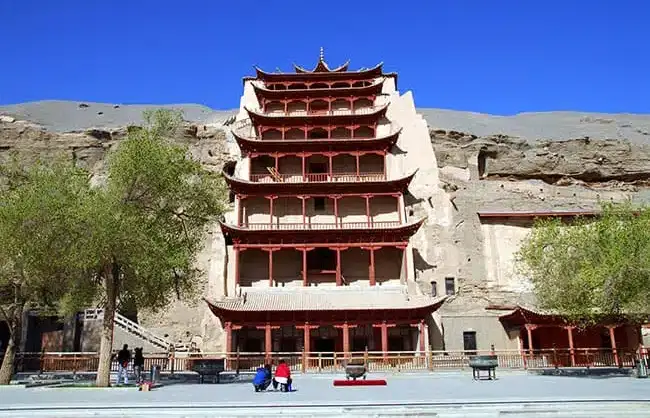
History: More than 1,600 years
Highlights: 735 grottoes; over 2,400 painted sculptures; 45,000 square meters of frescos,
Recommended Visiting Length: 3-4 hours
Location: About 10km to the center of Dunhuang City, Jiuquan City, Gansu Province
Located near the west end of Hexi Corridor in Dunhuang, Mogao Grottoes is the largest and richest Buddhist treasure trove in the world, which has witnessed the cultural exchanges between the East and the West along the ancient Silk Road.
The construction of Mogao Grottoes can be dated back to 366 when Buddhism was introduced into Dunhuang, and lasted for around 1,000 years to today’s scale. There are in total 735 caves and 492 of them are well-preserved with thousands of colored Buddha statues and fine murals depicting Sutra stories, flying Apsaras, natural landscapes…
Tips: If you have great interest in the history of Silk Road, you may extend your China tours to Kashgar and Hotan in Xinjiang, both of which were vital transportation hubs along the ancient trading route with a lot of historical sites await your exploration.
✔ Recommended China Silk Road tours:
- 7 Days Silk Road Small Group Tour of Xi’an – Zhangye – Dunhuang
- 10 Days Silk Road Tour from Xi’an to Kashgar
- 12 Days Ancient Silk Road Hexi Corridor Tour with Yinchuan
Three Confucius Sites, Qufu

Highlights: The Temple of Confucius, Kong Family Mansion, Cemetery of Confucius
History:
Temple of Confucius & Cemetery of Confucius: about 2,500 years;
Kong Family Mansion: nearly 650 years
Recommended Visiting Length: 4-6 hours
Location: The Temple of Confucius and Kong Family Mansion are located in the city center, and the Cemetery of Confucius is 2km to the north.
Qufu, Shandong Province is the hometown of Confucius (551-479BC), one of the greatest thinkers and educators in the world and also the originator of Confucianism. The Three Confucius Sites, consisting of the Temple of Confucius, Kong Family Mansion and the Cemetery of Confucius, have been a memorial to Confucius for thousands of years, and are considered as a great historical place in China for an in-depth exploration into the life of Confucius and Confucian values.
- The Temple of Confuciusis the world’s second largest ancient complex only after Forbidden City in Beijing. It was rebuilt on the former residence of Confucius for people to pay respect to this great ideologist.
- The Kong Family Mansionwa s home to Confucius’ descendants, covering an area of 74,000 square meters with 480 ancient rooms inside.
- The Cemetery of Confucius, founded in 479BC, is the graveyard of Confucius and the Kong family. More than 100,000 family members were buried here, and the tomb of Confucius is located in the very center.
Apart from the attractions mentioned above, there are still a great many ancient cities in China, like Luoyang, Hangzhou, Chengdu, and Nanjing, boasting breathtaking historical sites that transport visitors back in time.
If you want to have a historical tour in China, please feel free to contact us anytime! Our expert travel consultants are glad to help you with your itinerary.
Best China tour packages to famous historical sites:
- 8 Days Beijing –Xi’an – Shanghai Highlight Tour
- 10 Days Private Tour of Beijing –Xi’an – Chengdu – Shanghai
- 11 Days China Tour: Beijing –Xi’an – Yangtze Cruise – Shanghai







